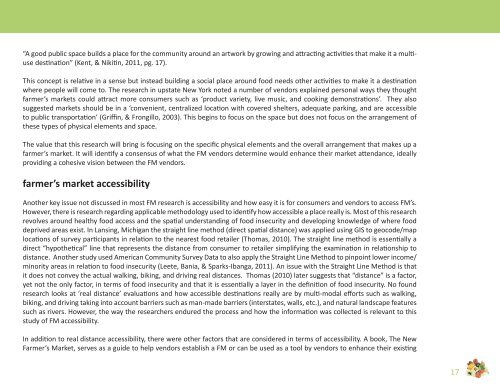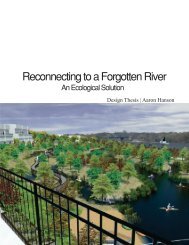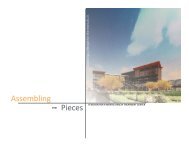Download PDF (28.7MB) - NDSU - North Dakota State University
Download PDF (28.7MB) - NDSU - North Dakota State University
Download PDF (28.7MB) - NDSU - North Dakota State University
You also want an ePaper? Increase the reach of your titles
YUMPU automatically turns print PDFs into web optimized ePapers that Google loves.
“A good public space builds a place for the community around an artwork by growing and attracting activities that make it a multiusedestination” (Kent, & Nikitin, 2011, pg. 17).This concept is relative in a sense but instead building a social place around food needs other activities to make it a destinationwhere people will come to. The research in upstate New York noted a number of vendors explained personal ways they thoughtfarmer’s markets could attract more consumers such as ‘product variety, live music, and cooking demonstrations’. They alsosuggested markets should be in a ‘convenient, centralized location with covered shelters, adequate parking, and are accessibleto public transportation’ (Griffin, & Frongillo, 2003). This begins to focus on the space but does not focus on the arrangement ofthese types of physical elements and space.The value that this research will bring is focusing on the specific physical elements and the overall arrangement that makes up afarmer’s market. It will identify a consensus of what the FM vendors determine would enhance their market attendance, ideallyproviding a cohesive vision between the FM vendors.farmer’s market accessibilityAnother key issue not discussed in most FM research is accessibility and how easy it is for consumers and vendors to access FM’s.However, there is research regarding applicable methodology used to identify how accessible a place really is. Most of this researchrevolves around healthy food access and the spatial understanding of food insecurity and developing knowledge of where fooddeprived areas exist. In Lansing, Michigan the straight line method (direct spatial distance) was applied using GIS to geocode/maplocations of survey participants in relation to the nearest food retailer (Thomas, 2010). The straight line method is essentially adirect “hypothetical” line that represents the distance from consumer to retailer simplifying the examination in relationship todistance. Another study used American Community Survey Data to also apply the Straight Line Method to pinpoint lower income/minority areas in relation to food insecurity (Leete, Bania, & Sparks-Ibanga, 2011). An issue with the Straight Line Method is thatit does not convey the actual walking, biking, and driving real distances. Thomas (2010) later suggests that “distance” is a factor,yet not the only factor, in terms of food insecurity and that it is essentially a layer in the definition of food insecurity. No foundresearch looks at ‘real distance’ evaluations and how accessible destinations really are by multi-modal efforts such as walking,biking, and driving taking into account barriers such as man-made barriers (interstates, walls, etc.), and natural landscape featuressuch as rivers. However, the way the researchers endured the process and how the information was collected is relevant to thisstudy of FM accessibility.In addition to real distance accessibility, there were other factors that are considered in terms of accessibility. A book, The NewFarmer’s Market, serves as a guide to help vendors establish a FM or can be used as a tool by vendors to enhance their existing17





